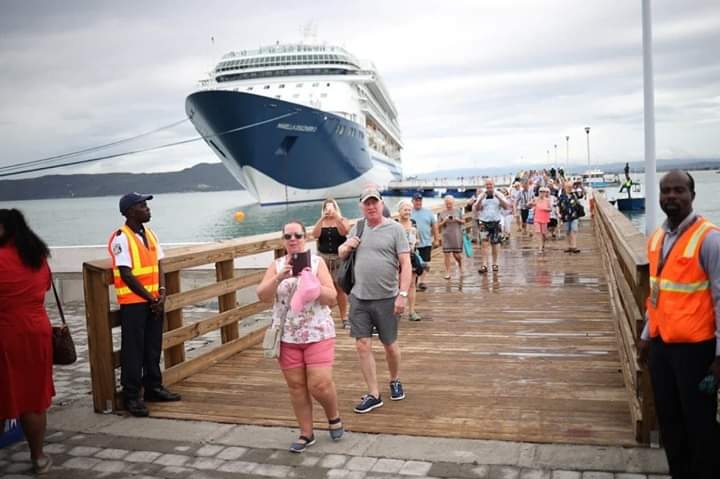
CARICOM’S inability to speak with one voice on issues confronting the region is again being exposed, this time concerning the differing COVID-19 travel protocols between the islands.
Cruise ship companies with billions of dollars in assets, in some cases worth substantially more than the total GDP of many of these small countries, are being confronted with different safety regimes as the industry looks to return to business in one of the sector’s more popular destinations.
With economies now cratering, many respective governments in the Caribbean are keen to see the return of the big ships. Having effectively been closed down earlier in Spring, the cruise liners will be adamant in their adherence to COVID-19 safety protocols and will be doing a cost analysis.
Many are concerned about confronting different regimes among small island states in close proximity to each other and will favour the governments of the Caribbean exhibiting uniformity on this.

Bringing the matter into context is the U.S. Centers for Disease Control and Prevention’s (CDC) recommendation that all people avoid cruise ship travel as the risk of COVID-19 on these vessels is high.
Caribbean countries including Jamaica have been calling for the reopening of cruise ships to their destinations but on its first voyage to the Caribbean since the outbreak, seven passengers on board the SeaDream 1 contracted the virus and had to make port in Barbados from the Grenadines.
“Cruise passengers are at an increased risk of person-to-person spread of infectious diseases including COVID-19 and outbreaks of COVID-19 have been reported on cruise ships,” said the CDC.
Last year, two million cruise visitors came to Jamaica generating J$23.5 billion in revenue. According to the Statistical Institute of Jamaica cruise tourism has jumped by close to 300 per cent over the last decade.

In a study released in 2018 by Business Research & Economic Advisors entitled, ‘Economic Contributions of Cruise Tourism to the Destination Economies’, cruise tourism to the Caribbean directly generated US$3.36 billion in total expenditures, six per cent higher than the figure of the study released in 2015.
Cruise tourism in the Caribbean led to 79,000 jobs with the cruise line companies paying out close to US$1 billion in wages across 36 countries in the region. This study reported 25.2 million onshore visits from cruise ship passengers with an average spend of US$100 generating over US$2.5 billion. Cruise lines spent $534 million, an average of US$14.8 million per destination.
The industry is big business for the Caribbean and forms a major artery for many of its economies. This latest announcement by the CDC will strike a dagger into the heart of winter tourism receipts and the prospects do not look promising with infection numbers and deaths rising both in the United States and Europe. Grand Cayman has already decided that cruise ships should not visit its port until at least 2021.
“In Jamaica, The Cayman Islands and the Turks & Caicos, Carnival Cruise Line threatened to pull its business after government officials attempted to stop ships carrying potentially sick passengers from docking in their ports or restricted which passengers could disembark. The three islands’ governments were left to make critical public health decisions under threat from a corporation that holds enormous sway over island economies.”
The Intercept
An analysis of the industry in the Caribbean and its impact on regional destination ports by Adrian Hilaire, submitted to the World Maritime University in 2007, reads: “The dissertation concludes by acknowledging the positive impacts of cruise tourism but notes that this may easily be offset by the negative impact of environmental degradation and the short-sightedness and lack of co-operation among destination ports.”
Many of the cruise companies are calling on the region to employ a uniform policy and act with one voice. Some cite the varying regimes as difficult to manage and a burden to their operations.
According to The Intercept, “In Jamaica, The Cayman Islands and the Turks & Caicos, Carnival Cruise Line threatened to pull its business after government officials attempted to stop ships carrying potentially sick passengers from docking in their ports or restricted which passengers could disembark. The three islands’ governments were left to make critical public health decisions under threat from a corporation that holds enormous sway over island economies.”
Fred Olsen Cruise Lines’ MS Braemar was one of the first cruise ships in the region to report COVID-19 infections. It was denied entry into many Caribbean ports including the Dominican Republic, St Maarten, Barbados and The Bahamas. It was Cuba that allowed it to dock on “humanitarian reasons”.

Much to the chagrin of many of the cruise lines, many Caribbean countries have refused entry into their ports fearing that it could lead to a mass outbreak of the virus. Some governments have said this decision has cost them as cruise lines have taken the decision to deal with friendlier ports or said they will remember that they were turned away.
Christopher Fitton of ‘I Choose To Cruise’, speaking with Our Today, said: “It is difficult for the cruise lines to come up with a Caribbean policy because they don’t know what they will be confronted with. Each of these small countries takes a different approach and so one cannot plan or count on certainties.”
Added Fitton: “In Jamaica, the head of tourism, Ed Bartlett, wants the cruise ships to return, yet the government would not allow their own citizens to return home and said ‘Keep away’. Cayman, which relies on the industry, shut its ports to cruise lines, Turks & Caicos turned its back… . With the Caribbean, what can you count on?”







Comments